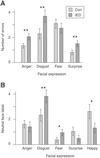Evidence for a dysfunctional prefrontal circuit in patients with an impulsive aggressive disorder
- PMID: 12034876
- PMCID: PMC123087
- DOI: 10.1073/pnas.112604099
Evidence for a dysfunctional prefrontal circuit in patients with an impulsive aggressive disorder
Abstract
Humans with lesions to the orbital/medial prefrontal cortex and interconnected areas display impulsive aggressive behavior. To examine further the relationship between impulsive aggression and orbital/medial prefrontal dysfunction, we measured the behavioral performance of psychiatric patients with a disorder characterized by impulsive aggression, Intermittent Explosive Disorder (IED). Presently, no evidence exists for a localized brain lesion in IED subjects. However, on the basis of the location of brain lesions that produce acquired impulsive aggression, we hypothesized that IED subjects would exhibit test performance similar to patients with lesions to the orbital/medial prefrontal cortex. Subjects with IED and controls were administered three tests sensitive to lesions of the orbital/medial prefrontal circuit: the Iowa Gambling Task, facial emotion recognition, and odor identification, and two control tests of working memory. On the gambling task, IED subjects continued to make disadvantageous decisions throughout the 100 trials, whereas controls learned to avoid disadvantageous decisions. On the facial recognition test, IED subjects were impaired at recognizing "anger," "disgust," and "surprise," and they were biased to label neutral faces with "disgust" and "fear." On odor identification, IED subjects were mildly anosmic and were impaired relative to controls. However, on the working memory control tests, both groups performed similarly. Across tests, the performance of IED subjects resembles the performance of patients with orbital/medial prefrontal lesions in previous studies. These results extend the link between dysfunction of the orbital/medial prefrontal circuit and impulsive aggressive behavior.
Figures




References
-
- Coccaro E F. Sci Am Sci Med. 1995;2:38–47.
-
- Davidson R J, Putnam K M, Larson C L. Science. 2000;289:591–594. - PubMed
-
- Coccaro E F. Harvard Rev Psychiatry. 1998;5:336–339. - PubMed
-
- Coccaro E F, Kavoussi R J. Arch Gen Psychiatry. 1997;54:1081–1088. - PubMed
-
- Fuster J M. The Prefrontal Cortex: Anatomy, Physiology, and Neuropsychology of Frontal Lobe. Philadelphia: Lippincott; 1998.
Publication types
MeSH terms
Grants and funding
LinkOut - more resources
Full Text Sources

